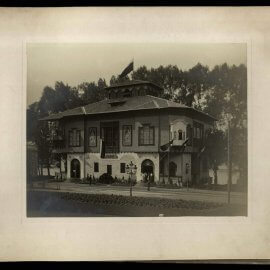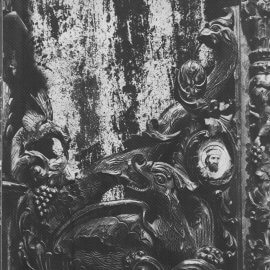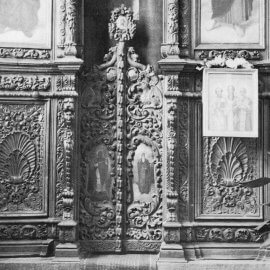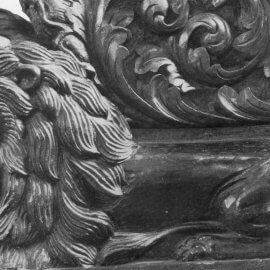Basic information
Born: 23 May 1881 (village of Genchovtsi, Municipality of Tryavna, District of Gabrovo)
Died: 7 March 1924 (city of Sofia)
Art education
1909–1910 - State Art School;
Wood carving in the churches of Sofia
- 12 January 1908 – 1 May 1909 – Church of the Saints Cyril and Methodius, 47 George Washington Street – an iconostasis;
- 21 March – 5 May 1909 – Church of the Saints Cyril and Methodius, 47 George Washington Street – a bishop’s throne;
- March 1910 – Church of the Saints Cyril and Methodius, 47 George Washington Street – a pulpit;
- 1911 – Church of St. Nicholas of Sofia the New, 76 Pirotska Street, a pulpit;
State of research
The work of Gencho Petrov Marangozov has aroused interest ever since the early 20th century. His contemporaries published information about him and his work in Tryavna, Turnovo and Sofia1Kozarov 1901; Kozarov 1901а; Nova tsarkva 1909; Shmid 1909; Chushkov 1928.. He has been cited as one of the last representative of Tryavna Woodcarving School who attempted at the same time to adhere to the contemporary tendencies in church wood-carving2Drumev 1982: 193.. The attention of the art historians has been focused mainly on the work of the wood-carver at the Church of the Saints Cyril and Methodius in Sofia3Vasiliev 1952: 263; Drumev, Vasiliev 1955: 11; Drumev 1962: 183-189; Vasiliev 1965: 123-124; Drumev 1982: 193; Entsiklopediya 1987: 34-35; Angelov 1985: 12; Angelov 1986: 159; Angelov 1988: 31-32; Angelov 1998: 26; Angelov 2015: 24.. Most often it is stated that among his works is the iconostasis, while the fact that he made the entire woodwork of the church is ignored. His work in the Church of St. Nicholas of Sofia the New has also been commented in passing. The art studies do not pay sufficient attention to the existing documentary sources that clarify the stages of performance of the wood-carving works in the churches of the Saints Cyril and Methodius and of St. Nicholas of Sofia the New4Part of documentary evidence of the work of Gencho Marangozov in the two churches in Sofia were commented by H. Jemelski and S. Tabakov. See Temelski 2000: 70-71; Tabakov 2009: 70-73., their donors, the team Gencho Marangozov worked with as well as the payment he received for his work.
Biography
Gencho Petrov Marangozov is one of the last representatives of the Genchovtsi family of builders and woodcarvers5Vasiliev 1952: 246-263; Drumev 1962: 292-298.. He was born in 1881 in the village of Genchovtsi6Vasiliev 1952: 262. G. Marangozov stated the year of his birth in an inscription on a relief made for the home of Avram Chalyovski. The relief is currently kept at the Specialized Museum of the Art of Woodcarving and Icon-Painting in the town of Tryavna. See Specialized Museum of the Art of Woodcarving and Icon-Painting – Tryavna, Oist No. 524, p. 14.. He was the second son of Petar Genchev7Petar Ganchev (1850–1902). About him see Kozarov 1901: 68; Vasiliev 1952: 261; Drumev 1962: 257, 292-293; Vasiliev 1965: 122-123. See also Specialized Museum of the Art of Woodcarving and Icon-Painting – Tryavna, Oist No. 524, p. 3-4., also a woodcarver.
G. Marangozov began his education at the age of 7 at the elementary school in the village of Bizhovtsi near Tryavna. As early as in the third grade he decided to leave school and travel with his father to learn the art of woodcarving8Kozarov 1901: 68; Kozarov 1901а: 135-136; Vasiliev 1952: 262-263; Vasiliev 1965: 123; Entsiklopediya 1987: 34. See also Specialized Museum of the Art of Woodcarving and Icon-Painting – Tryavna, Oist No. 524, p. 4.. It seems that the first commission he was involved in as a woodcarver is the iconostasis of the Church of All Saints in Ruse where he helped his father in his work9Kozarov 1901: 69; Kozarov 1901а: 135-136; Drumev, Vasiliev 1955: 11; Vasiliev 1965: 123.. Together with him he worked also in the villages of Kulata (district of Ruse), Skortsite (district of Tryavna), Genchovtsi and Chakalite (district of Dryanovo) and others10Kozarov 1901: 69; Kozarov 1901а: 136; Drumev, Vasiliev 1955: 11..
In 1898, he opened his own woodcarving workshop in Tryavna11Kozarov 1901: 69; Kozarov 1901а: 135-136; Drumev, Vasiliev 1955: 11; Drumev 1962: 16, 293; Vasiliev 1965: 123; Specialized Museum of the Art of Woodcarving and Icon-Painting – Tryavna, Oist No. 524, page 5. In the Encyclopedia of Visual Arts in Bulgaria it is erroneously stated that the workshop was opened in the village of Genchovtsi. See Entsiklopediya 1987: 34.. Until he was conscripted in the army in 190012According to the data from the matriculation books of the State Art School Gencho Marangozov’s conscription ended on 16 December 1904. I thank Chief Assistant Professor Maria Miteva, PhD for this piece of information.. G. Marangozov made home iconostases, royal doors and crosses. In 1899–1900, he made an iconostasis, a bishop’s throne and a proskinetarion for the Church of St. Archangels in the village of Gorski Senovets near Veliko Turnovo13Kozarov 1901: 69; Kozarov 1901: 136; Drumev 1962: 294; Vasiliev 1965: 123; Drumev 1982: 193; Entsiklopediya 1987: 34. See also Specialized Museum of the Art of Woodcarving and Icon-Painting – Tryavna, Oist No. 524, p. 6..
It is not clear when the woodcarver settled in Sofia. According to some researchers in 1905 he took part in the making of pieces of furniture for the exhibition in Liège14Vasiliev 1965: 124; Entsiklopediya 1987: 34; Ninova 2004: 142.. However, D. Drumev thinks that the woodcarver moved to Sofia in the period 1906–190715Drumev 1962: 183., while A. Vasiliev claims that it was not until 1908 when he started to work on the iconostasis in Church of the Saints Cyril and Methodius that he actually moved there16Vasiliev 1965: 124.. Most likely the woodcarver settled in Sofia sometime in the period between 1900 and 1905 as suggested by А. Roshkovska17Specialized Museum of the Art of Woodcarving and Icon-Painting – Tryavna, Oist No. 524, p. 6.. In the first decade of the 20th century Gencho Marangozov also resided for a while in Veliko Turnovo. This is attested by the Russian ambassador Theodor Schmidt who met the woodcarver in Turnovo about 1908–190918Scmid 1909: 424. . This information is also confirmed by a letter sent from the Sofia police to the board of trustees of the Church of the Saints Cyril and Methodius which mentions that in 1910 the woodcarver of Tryavna was in Turnovo19DA – Sofia, f. 1146k, inv. 2, a.u. 3, p. 51..
In Sofia Gencho Marangozov did mainly woodcarving works of secular and ecclesiastical nature. The earliest known commission he took part in was the making of pieces of furniture at the factory of Ivan (Jan) Bruha20The factory of Ivan Bruha was founded in 1895. See Velinova, Markova, Nachev 2017: 69. for the exhibition in Liège in 190521Vasiliev 1965: 124; Entsiklopediya 1987: 34; Vasilchina 1989: 41; Ninova 2004: 142. For the exhibition in Liège see Protich 1928: 188; Genova 1999: 18; Georgieva 1999: 37; Izvori 2002: 225-226.. In the literature it is stated that on that commission G. Marangozov worked jointly with the Tryavna woodcarvers Petar Kanchev22About Petar Kanchev see Vasilchina 2008; Vasilchina 2008а; Vasilchina 2014: 182., Ivan Kasev and Totyu Slavkov23Boneva 1985: 218, № 93.. After he completed his work for the exhibition in Liège G. Marangozov did commissions for the royal palace24Vasiliev 1965: 124. See also Specialized Museum of the Art of Woodcarving and Icon-Painting – Tryavna, Oist No. 524, p. 7.. In 1909–1910, he attempted to receive art education in the speciality of Woodcarving at the State Art School but he left at his request on 15 December 191025According to the data from the matriculation books of the State Art School. I thank Chief Assistant Professor Maria Miteva, PhD for this piece of information.. In the period from 1913 to 1920 he made, together with the woodcarvers Gencho Genchev Novakov and Totyu Slavkov, a bedroom, household objects, bas-reliefs, statues of khans and tsars for the “patriotic room”, a study and a library for the home of Avram Chalyovski which was at 34 Paisiy Street in Sofia26Drumev 1982: 193; Boneva 1985: 210, № 125; Ninova 2008: 21. Part of the works are currently kept at the Specialized Museum of the Art of Woodcarving and Icon-Painting in Tryavna. About the collection see Penchev 1968; Hristova 1974: 4; Specialized Museum of the Art of Woodcarving and Icon-Painting – Tryavna, Oist No. 524, pp.14-49.. In addition to the commissions in the Churches of the Saints Cyril and Methodius and of St. Nicholas of Sofia the New in Sofia the woodcarver also made church woodcarving works for churches in the vicinity of Sofia. Today it is known that he carved the iconostases for Buchin Prohod, Vladaya and Kostinbrod27Vasiliev 1965: 124; Entsiklopediya 1987: 34.. G. Marangozov also took commissions for the churches in Kesarevo, Debelets, the village of Dobrina (district of Varna), Zlokuchen and others28Vasiliev 1965: 124; Entsiklopediya 1987: 34. See also Specialized Museum of the Art of Woodcarving and Icon-Painting – Tryavna, Oist No. 524, pp. 12-13..
Gencho Marangozov’s contemporaries described him as an experienced woodcarver who became famous shortly after he opened his own workshop in Tryavna. Here is what G. Kozarov wrote about him: “He is a young, nice agile lad; I found him at his workshop where he made doors commissioned for the iconostasis of a village church in the district of Kesarevo. I could not stop wondering at his skill and dexterity. He had never gone to any academy of sculpture he worked with his chisel as a gifted sculptor. The royal doors he was working were a real masterpiece. Everything he did came out of his imagination: he did himself the sketches, he caved them on his own. The rosette in the middle of the doors, the dragon encircling the upper part of the door wings as well as the numerous flowers that filled the empty spaces spoke of the talent of the master and of his skill to command the forms characteristic of the Bulgarian ornaments.”29Kozarov 1901: 68.
After he settled in Sofia it seems that he quickly gained popularity among the residents of Sofia. This is attested by a protocol in the book of the board of trustees of the Church of the Saints Cyril and Methodius30DA – Sofia, f. 1146к, inv. 1, a.u. 1, p. 17., where he is noted as the “famous woodcarving master Gencho Marangozov.” For his work on the woodcarving pieces in the same church he was awarded the Public Service Medal31The Public Service Medal was established on 2 August 1891 by Prince Ferdinand I with the intention to honor public servants, public figures, ministers, high-ranking clerics, diplomats, doctors, artists, journalists, etc. See Denkov 2001: 60-82; Pavlov 2015: 146-205. in 190932Vasiliev 1965: 124; Entsiklopediya 1987: 34; Angelov 1988: 32; Angelov 1992: 75.. Nevertheless Ivan N. Kasev who worked with the woodcarver wrote to A. Vasiliev that G. Marangozov “lives in poverty in the outskirts of the city”33Vasiliev 1965: 124; Vasilchina 1989: 41..
In the literature it is noted that the woodcarver had no students34Chushkov 1928: 265.. However, according to another opinion the woodcarvers Vlado Stoilov and Nisim Haim Sadchi studied with him35Vasiliev 1965: 124..
He died of tuberculosis on 7 March 1924 in Sofia36Vasiliev 1952: 263; Vasiliev 1965: 124..
Wood carving in the churches of Sofia
In the period 1908–1911, Gencho Marangozov led the works on the making of the iconostasis, the bishop’s throne and the pulpit for the Church of the Saints Cyril and Methodius37Vasiliev 1952: 263; Kadiev 1959: 4; Drumev 1962: 183-189, 293; Vasiliev 1965: 124, 125, ill. 66; Drumev 1982: 185, 193; Angelov 1985: 12; Boneva 1985: 199, No. 219; Angelov 1986: 159; Entsiklopediya 1987: 34, 35; Angelov 1988: 31; Drumev 1989: 203, ill. 28a, b; Angelov 1992: ill. 169, 170, 171; Angelov 1998: 26; Koeva, Yokimov, Stoilova 2002: 433; Ninova 2008: 21; Angelov 2015: 24. in Sofia which are still there. The iconostasis is wood-carved, with no gild. It is made of walnut tree, and the bearing structure is made of coniferous wood38Kolev 2008: 130-139.. The bishop’s throne and the pulpit are not gilded as well.
In the art historical literature has not been made clear when the iconostasis was carved. It is asserted that Gencho Marangozov submitted projects for an iconostasis, a pulpit and a bishop’s throne in 1908 and that he made them in 191139Angelov 1985: 12.. Most often the iconostasis is dated 190840Vasiliev 1952: 263; Drumev 1962: 184; Vasiliev 1965: 124; Drumev 1982: 193; Angelov 1986: 159; Angelov 1988: 31; Angelov 1998: 26.. It has also been erroneously claimed that Gencho Marangozov participated in the competition to make the woodcarving decoration of the church announced in 1908. The preserved documentary evidence shows that the competition was announced as early as in May 190741Tabakov 2009: 40. when the construction works for the church’s building were completed42According to the most recent studies the construction of the Church of the Saints Cyril and Methodius began in 1892 and ended in 1907. See Tabakov 2009: 15-36; Yontcheva 2020: 198. Some publications state the year 1897 as the year when construction started. See Varbanova, Lostova-Topalova, Petrova, Ivanov 2020: 19.. Initially, three woodcarvers took part in the competition. The woodcarver Ivan Yonkov offered to make the church furniture in one year for a price of 28,000 Bulgarian leva; Filip Ivanov offered two projects, one for a price of 25,000 Bulgarian leva, and the other for a price of 40,000 Bulgarian leva; Nestor Aleksiev offered a project for a period of 4 years at a price of 40,000 Bulgarian leva. Their bids were rejected by the then Bishop of Sofia Parteniy43Tabakov 2009: 40-41..
Just one year later the church’s board of trustees accepted the project of Gencho Marangozov who offered to make the iconostasis between 12 January 1908 and 1 May 1909 for a price of 12,000 Bulgarian leva44Vasiliev 1965: 124; Tabakov 2009: 41. See also DA – Sofia, f. 1146k, inv. 2, a.u. 41, p. 21.. The contract concluded between the woodcarver and the church’s board of trustees is not preserved but the conditions are known from other sources. A certificate evidencing the work of G. Marangozov in the church mentions that the contract for the iconostasis was signed on 12 January 1908 and the deadline for the installation thereof in the church, i.e. 1 May 1909, was met45Specialized Museum of the Art of Woodcarving and Icon-Painting – Tryavna, OR No. 288 , p. 1.. Documentary sources also show that Gencho Marangozov worked in partnership with Ivan Kolev Kasev. This is evidenced in a letter sent by Ivan K. Kasev to the church’s board of trustees in which he requested that the remainder of the sum for the commission be paid in his presence46DA – Sofia, f. 1146k, inv. 2, a.u. 1, p. 17 verso-18 verso.. The sources also show that the entire sum for the iconostasis was paid with some delay. Most likely the reason for that was the injunction imposed by the police in Sofia on the sums received by Gencho Marangozov47DA – Sofia, f. 1146k, inv. 2, a.u. 3, p. 51-52. as the causes for that injunction currently remain unknown. On 11 December 1910, the church’s board of trustees decided to pay the remainder of the agreed sum for the iconostasis in 1911.48DA – Sofia, f. 1146k, inv. 1, a.u. 1, p. 33. Препис на този протокол виж DA – Sofia, f. 1146k, inv. 2, a.u. 2, p. 6-6 verso.
In addition to Gencho Marangozov and Ivan Kasev some other woodcarvers of Tryavna took part in the making of the iconostasis: Gencho Genchev Novakov of the village of Genchovtsi, Totyu Slavkov of the village of Radantsi49About him see Ninova 2004., Gancho Petrov of the village of Genchovtsi, Gancho Kolev Kasev of the village of Genchovtsi, Atanas Yordanov of Turnovo and Iliya Yordanov Zografski of the village of Voditsa 50Drumev 1962: 294; Drumev 1982: 193..
Even before the completion of his work on the iconostasis G. Marangozov proposed a project for a bishop’s throne51Drumev 1989: 393, ill. 13а., which was approved by the Sofia Bishopric on 18 March 190952DA – Sofia, f. 1156k, inv. 1, a.u. 6, p. 158-159.. The bishop’s throne was made between 21 March 1909 and 5 May 190953Tabakov 2009: 42..
Different sources show that the completion of the iconostasis caused a strong reaction among the residents of Sofia. Just a couple of days after it was installed a brief chronicle about the church was published in Vechena Poshta [Evening Post] newspaper. The chronicle explicitly noted the work of Gencho Marangozov who made “an iconostasis of remarkable richness… in an old-fashioned woodcarving style”54Nova tsarkva 1909: 2.. Gencho Marangozov himself recalled the praise for the work of the Tryavna woodcarvers in a letter to the church’s board of trustees in which he wrote: “You are well aware of the great dexterity I have employed to do the work commissioned by you, and namely: to make the iconostasis and the bishop’s throne, and also of the numerous praises from everywhere, even from His Majesty the King.”55DA – Sofia, f. 1146k, inv. 2, a.u 1, p. 16.
Shortly after the consecration of the church56The church was consecrated on 10 May 1909. See Svedeniya 1951; Kadiev 1959: 4; Tabakov 2009: 59-61. Gencho Petrov sent an offer to the church’s board of trustees for the making of a king’s throne and a pulpit to be completed by May 1910 for a total price of 7,000 Bulgarian leva.57DA – Sofia, f. 1146k, inv. 2, a.u. 1, p. 16-16 verso. According to S. Tabakov his offer was rejected by the board of trustees. In early 1910, Andrey hadzhi Isov sent a letter to the church’s board of trustees informing them that he intended to donate the sum for carving the pulpit58DA – Sofia, f. 1146k, inv. 2, a.u. 3, p. 13. See also Kadiev 1959: 4; Tabakov 2009: 61., to be made based on Gencho Marangozov’s design59DA – Sofia, f. 1146k, inv. 2, a.u. 3, p. 14. Tabakov 2009: 71.. It seems that was perceived well by the board of trustees because on 19 January 1910 they decided to send a request to the Sofia Bishopric for the approval of the design60DA – Sofia, f. 1146k, inv. 1, a.u. 1, p. 17.. It was examined by the Sofia Bishopric on 22 January 191061DA – Sofia, f. 1156k, inv. 1, a.u. 7, p. 33 verso. and shortly afterwards a response was sent to the board of trustees that the pulpit had been approved with minor adjustments62DA – Sofia, f. 1146k, inv. 2, a.u. 3, p. 15. See also Minutes No. 8 of 5 February 1910 of the Sofia Bishopric, DA – Sofia, f. 1156k, inv. 1, a.u. 7, p. 49 verso-50. . The work on the pulpit started in March63Tabakov 2009: 72., and on 5 April 1911 the church’s board of trustees notified Andrey Isov that the pulpit commissioned by him had already been put in the church64DA – Sofia, f. 1146k, inv. 2, a.u. 2, p. 18-18 verso..
In 1909, the board of trustees commissioned Gencho Marangozov to make the stasidia and he did them until the end of the following year65DA – Sofia, f. 1146k, inv. 2, a.u. 3, p. 43-44, 48, 77, 82-82 verso..
Even before the final completion of his work in the Church of the Saints Cyril and Methodius Gencho Marangozov was commissioned to make a pulpit for the Church of St. Nicholas of Sofia the New66Vasiliev 1965: 124; Boneva 1985: 200, No. 219; Entsiklopediya 1987: 34; Temelski 2000: 70-71; Koeva, Yokimov, Stoilova 2002: 441. See also също Specialized Museum of the Art of Woodcarving and Icon-Painting – Tryavna, Oist No. 524, p. 13.. The pulpit is wood carven, with no gild. He started making it in 1910 when Avram Chalyovski informed the church’s board of trustees that he would donate a pulpit for the churchа67Temelski 2000: 70.. The plan for the pulpit was approved by the Sofia Bishopric on 5 February 191068DA – Sofia, f. 1156к, inv. 1, a.u. 7, p. 49.. It was completed on 3 March 1911 when it was accepted by a commission chaired by the Bishop of Levki Varlaam69Temelski 2000: 71.. The donor’s inscription is placed in the bottom of the pulpit, on an open code: “Made at the expense of Avram M. Chalyovski, born in the village of Galičnik, district of Debar, Macedonia”70Temelski 2000: 71, with quoted archive sources..
Darina Boykina













